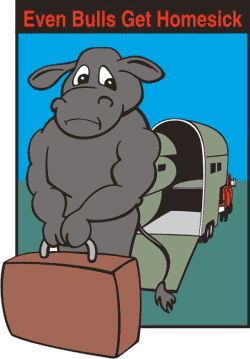
Kris Ringwall
Beef Talk
Adapt new bulls to their new home slowly.
After a spring of bull shopping, the first thing one realizes is there are a lot of good bulls on the market. The strong selection makes for fun shopping — reviewing the highlighter markings of the good traits of each bull in the catalog, bidding vigorously and eventually owning the bull of your choice.
The second obvious point has to do with soundness. Sound bulls are structurally correct and blend with their environment. In fact, bulls are products of their environment.
The best way to treat new bulls is to place them in an environment similar to the one they came from. While a smooth transition is important, this is not always possible.
Some of the genetics a producer buys may be from another state or region. While challenging, the transition is very important because overlooking the adjustment period in settling a new bull can be devastating. The end result shows when new bulls fail to meet expectations.
 Perhaps, producers need to think about their own personal, life-changing events that did not always sit well. Where should one start? The first obvious life change was birth, but none of us really remember that (excuse me, moms), so maybe we should think about our first day away from home.
Perhaps, producers need to think about their own personal, life-changing events that did not always sit well. Where should one start? The first obvious life change was birth, but none of us really remember that (excuse me, moms), so maybe we should think about our first day away from home.
Our lives not only changed, but our bodies needed to adapt to new surroundings, food and companions. For some, the transition may have been uneventful; for others, it was darn miserable.
If that does not ring a bell, think about broken relationships, friendships, estrangement or death. We need to get a handle on how these events affect our lives and bodies as well. We can personally relate to friends or acquaintances who have experienced change and struggled with the effects.
There is a huge difference between how humans and bulls perceive things, but the effects of change still are present, even if it is just a bull.
To start, feed changes, if any, should be gradual. Ask what type of ration the bull was eating prior to being delivered. Keeping similar feed in front of the new arrival is good.
Don't wait. Bulls are ruminants. You are feeding the bull and the many living organisms in his rumen. Rumen organisms do not like to be messed with. If a significant portion of the rumen microbes die, the bull won't do well, either. So, start simple by mimicking the previous feed ration if at all possible. If the bull was on a ration high in grain, the microbes in the rumen will be adapted to it. If the bull was developed on forage, the microbes of the rumen will be more geared to digesting forage. Feed accordingly!
Take two to four weeks to slowly adjust the bull to your localized diet. If you don't … well, your new bull purchase may have four feet up the next day.
Generally, that does not happen. What does happen is the bull's body takes longer than needed to adjust. If the adjustment gets rough, the bull's fertility decreases. Infertile bulls produce open cows. Open cows frustrate producers. Frustrated producers make life difficult for bull breeders.
Producers will say the bull wasn't any good in the first place. Wrong. Most bulls are fertility tested. Those that aren't fertile aren't sold.
The next conclusion is that the newly purchased bull was transitioned poorly, which ultimately triggered a fertility setback. Take time to adapt bulls to their new surroundings and pay attention to their nutrition. In return, the bulls will settle your cows.
Your comments are always welcome at www.BeefTalk.com. For more information, contact the North Dakota Beef Cattle Improvement Association (NDBCIA) Office, 1041 State Ave., Dickinson, ND 58601, or visit www.CHAPS2000.com on the Internet.





